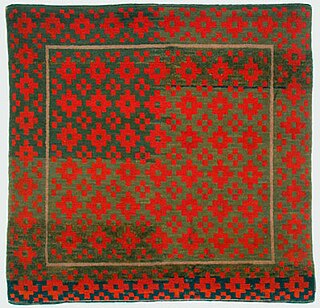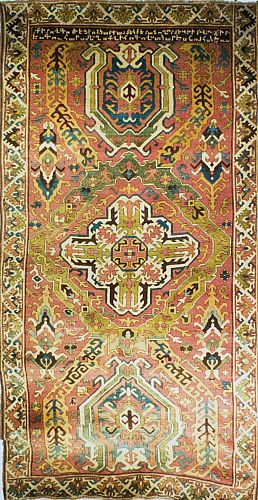
A carpet is a textile floor covering typically consisting of an upper layer of pile attached to a backing. The pile was traditionally made from wool, but since the 20th century synthetic fibers such as polypropylene, nylon, or polyester have often been used, as these fibers are less expensive than wool. The pile usually consists of twisted tufts that are typically heat-treated to maintain their structure. The term carpet is often used in a similar context to the term rug, but rugs are typically considered to be smaller than a room and not attached to the floor.

Tibetan rug making is an ancient, traditional craft. Tibetan rugs are traditionally made from Tibetan highland sheep's wool, called changpel. Tibetans use rugs for many purposes ranging from flooring to wall hanging to horse saddles, though the most common use is as a seating carpet. A typical sleeping carpet measuring around 3 ft × 5 ft is called a khaden.

A Persian carpet or Persian rug, also known as Iranian carpet, is a heavy textile made for a wide variety of utilitarian and symbolic purposes and produced in Iran, for home use, local sale, and export. Carpet weaving is an essential part of Persian culture and Iranian art. Within the group of Oriental rugs produced by the countries of the "rug belt", the Persian carpet stands out by the variety and elaborateness of its manifold designs.

The Iranian city of Isfahan has long been one of the centres for production of the famous Persian carpet. Isfahani carpets are renowned for their high quality. The most famous workshop in Isfahan is Seirafian. In Europe, they became incorrectly known as Polish rugs because of the trade route from Persia to France running through Poland.

Uşak carpets, Ushak carpets or Oushak Carpets are Turkish carpets that use a particular family of designs, called by convention after the city of Uşak, Turkey – one of the larger towns in Western Anatolia, which was a major center of rug production from the early days of the Ottoman Empire, into the early 20th century.
An oriental rug is a heavy textile made for a wide variety of utilitarian and symbolic purposes and produced in "Oriental countries" for home use, local sale, and export.
Milas carpets and rugs are Turkish carpets and rugs that bear characteristics proper to the district of Milas in Muğla Province in southwestern Turkey. There are also a number of variants within the definition of Milas carpets. These variants are called under such names as Ada Milas, Patlıcanlı, Cıngıllı Cafer, Gemisuyu, and Elikoynunda, depending on the style, colors and other characteristics.

Anatolian rug is a term of convenience, commonly used today to denote rugs and carpets woven in Anatolia and its adjacent regions. Geographically, its area of production can be compared to the territories which were historically dominated by the Ottoman Empire. It denotes a knotted, pile-woven floor or wall covering which is produced for home use, local sale, and export. Together with the flat-woven kilim, Anatolian rugs represent an essential part of the regional culture, which is officially understood as the Culture of Turkey today, and derives from the ethnic, religious and cultural pluralism of one of the most ancient centres of human civilisation.

Hereke carpets are Turkish handmade carpets produced and sold in Hereke, a coastal town in Turkey. For a long time, they used to be produced only in Hereke, 60 km from Istanbul. The materials used are silk, a combination of wool and cotton, and sometimes gold or silver threads.

A Turkmen rug is a type of handmade floor-covering textile traditionally originating in Central Asia. It is useful to distinguish between the original Turkmen tribal rugs and the rugs produced in large numbers for export mainly in Pakistan and Iran today. The original Turkmen rugs were produced by the Turkmen tribes who are the main ethnic group in Turkmenistan and are also found in Afghanistan and Iran. They are used for various purposes, including tent rugs, door hangings and bags of various sizes.
A Pakistani rug, also known as Pakistani carpet, is a type of handmade floor-covering heavy textile traditionally made in Pakistan and is used for a wide variety of utilitarian and symbolic purposes. Rug/carpet weaving is an essential part of Pakistani culture and Pakistani art.

Sultanabad rugs and carpets are floor coverings of distinctive design made in Arak, Iran since the 19th century.
A Sarouk rug is a type of Persian rug from Markazi Province in Iran. Sarouk rugs are those woven in the village of Saruk and also the city of Arak and the surrounding countryside.

The term Armenian carpet designates, but is not limited to, tufted rugs or knotted carpets woven in Armenia or by Armenians from pre-Christian times to the present. It also includes a number of flat woven textiles. The term covers a large variety of types and sub-varieties. Due to their intrinsic fragility, almost nothing survives—neither carpets nor fragments—from antiquity until the late medieval period.
Amritsar rugs and carpets are produced in Amritsar, located in the northwest of India, near the Kashmir region. While India does in fact boast a long history of weaving fine rugs and carpets, Amritsar rugs are unique in the wide gamut of traditional Indian styles. This is because the weavers of Amritsar had not developed a distinctive style of rug making until the early nineteenth century – hundreds of years after other regions of India had first developed their own weaving traditions. While regions of southern and western India began weaving Persian-influenced rugs during the reign of the Mughal emperors, who preferred the traditional aesthetics and design elements of the Persians, the weavers of Amritsar took their direction from somewhere different: the sensibilities of the West.

Kerman carpets are one of the traditional classifications of Persian carpets. Kerman is both a city and a province located in south central Iran. The term also sometimes describes a type which may have been made elsewhere. Kerman rugs are prized for a wide range of designs, a broad palette, use of natural dyes and fibers, great tensile strength and abrasion resistance, and expert color combinations. Typical manufacturing use an asymmetrical knot on cotton foundation, but rare examples imay include silk or part silk piles, or silk foundations with wool pile.

A pictorial carpet, picture carpet, tableau rug, carpet tableau or rug tableau is an ornamental rug specially prepared for hanging on room and hall walls for decoration. The designs and samples on pictorial carpets are completely different from those on common floor rugs. Pictorial carpets are generally made of silk but they have also been made from wool. Pictorial carpets are usually framed to sell and use.
DOBAG is the Turkish acronym for "Doğal Boya Araştırma ve Geliştirme Projesi". The project aims at reviving the traditional Turkish art and craft of carpet weaving. It provides inhabitants of a rural village in Anatolia – mostly female – with a regular source of income. The DOBAG initiative marks the return of the traditional rug production by using hand-spun wool dyed with natural colours, which was subsequently adopted in other rug-producing countries.

The Oriental Carpet Manufacturers (OCM) was a London-based company involved in the production of, and trade with, Oriental carpets. Established in 1907/8 in Istanbul, the company set up and controlled their own carpet manufactures in the central Anatolian region around the town of Konya, and from 1911 onwards, in the Hamadan Province in northwestern Iran. In 1968 it was sold, and merged with one of its former affiliates, the Eastern Kayyam Company. From 1924 until 1948, OCM was led by Arthur Cecil Edwards, who, after retiring, wrote a text book on Persian Carpets, which is still in print today.
Qaleen is a type of hand knotted piled carpet. The term is used throughout Turkey, Iran and Central Asia, and making qaleens is currently practised as a handicraft in Turkey and Iran. Artisans may need at least two months to make one qaleen. The craft was learned from Persians by the artisans of Kashmir on the Indian subcontinent. These knotted pile carpets so were a blend of Persian and Indian craftsmanship. ''Qaleens'' or ''Ghalichas'' were made in the Kashmir region of India and Pakistan.












